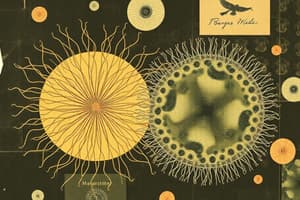Podcast
Questions and Answers
What are unicellular organisms made up of?
What are unicellular organisms made up of?
- One cell (correct)
- Many cells
- None of the above
- Several types of cells
Who invented the first compound microscope?
Who invented the first compound microscope?
Zacharias Janssen
All living organisms are composed of one or more cells.
All living organisms are composed of one or more cells.
True (A)
Which of the following describes the cell theory?
Which of the following describes the cell theory?
What does 'Omnis cellula e cellula' mean?
What does 'Omnis cellula e cellula' mean?
Francesco Redi experimented on _____ in jars.
Francesco Redi experimented on _____ in jars.
What type of cells lack a nucleus?
What type of cells lack a nucleus?
Which part of the cell is considered the powerhouse?
Which part of the cell is considered the powerhouse?
Chloroplasts are involved in cellular respiration.
Chloroplasts are involved in cellular respiration.
Cell division in prokaryotes occurs through _____ fission.
Cell division in prokaryotes occurs through _____ fission.
Match the following types of cells with their characteristics:
Match the following types of cells with their characteristics:
What is the main function of ribosomes?
What is the main function of ribosomes?
What do lysosomes do?
What do lysosomes do?
Name a type of modification found on the apical surface of a cell.
Name a type of modification found on the apical surface of a cell.
The outer covering of plant cells is called the _____ wall.
The outer covering of plant cells is called the _____ wall.
Flashcards are hidden until you start studying
Study Notes
Foundation of Life: Cells
- Cells are the basic unit of life and regenerate at night.
- Unicellular organisms consist of a single cell (e.g., bacteria, protozoa).
- Multicellular organisms comprise multiple cells (e.g., plants, animals).
Historical Developments in Microscopy
- Romans experimented with glass in the first century, creating lenses.
- Zacharias Janssen invented the first compound microscope around 1595, likely with help from his father, Hans.
- Robert Hooke observed cork under a microscope in 1665, describing its structure as "cells."
- Anton van Leeuwenhoek was the first to observe live cells, inventing microscopes with lenses that could magnify objects 270-300 times.
Cell Theory
- All living organisms are composed of one or more cells.
- The cell is the basic structural and functional unit of all organisms.
- Cells arise from pre-existing cells.
Key Contributors to Cell Theory
- Matthias Jakob Schleiden (1838) stated that cells are the building blocks of plants.
- Theodor Schwann (1839) declared that cells are fundamental units of animals, merging plant and animal cell structure concepts.
- Rudolf Virchow (1855) presented "Omnis cellula e cellula," asserting all cells come from existing cells.
Theory of Spontaneous Generation
- Suggests organisms can arise from non-living sources.
- Francesco Redi's experiments with jars and meat demonstrated that maggots do not spontaneously generate.
- John Needham's chicken broth experiment appeared to support spontaneous generation.
- Lazzaro Spallanzani countered Needham, showing no microorganisms grew in sealed broths.
- Louis Pasteur confirmed that microorganisms originate from the air through his S-shaped flask experiment.
Cell Structure and Function
- Cell Wall: Protects and supports plant cells; prevents excessive water uptake.
- Cell Membrane: Protects cells; is semipermeable, controlling substance movement.
- Nucleus: Acts as the cell's control center, managing all activities.
- Cytoplasm: Site of physiological processes, supporting organelles.
- Ribosomes: Sites for protein synthesis and assembly.
- Golgi Body: Packages proteins for transport outside the cell.
- Endoplasmic Reticulum (ER): Transports materials; rough ER has ribosomes, while smooth ER detoxifies substances.
- Lysosomes: Break down old organelles; termed "suicide bags" of the cell.
- Chloroplasts: Found in plant cells; contain chlorophyll for photosynthesis.
- Vacuoles: Storage for food, water, and waste materials.
- Mitochondria: Powerhouses of the cell, generating ATP energy.
- Flagella and Cilia: Aid in locomotion and movement of cells.
- Centrioles: Assist with cell division and organization of microtubules.
- Peroxisomes: Conduct oxidative reactions and recycle molecules.
Cellular Characteristics of the Five Kingdoms
- Plantae: Capable of photosynthesis; contains cell walls made of cellulose.
- Fungi: Decomposers; reproduce via spores/budding; composed of hyphae.
- Animalia: Most complex, multicellular organisms with diverse cell types (e.g., osteocytes, neurons).
- Protista: Mostly unicellular; includes protozoa with various locomotion strategies.
- Eubacteria: Comprising complex, unicellular organisms in different shapes (cocci, bacilli, spirilla); includes extremophiles.
Cell Modification
- Cell specialization occurs post-division, allowing cells to effectively perform their functions.
- Apical Modifications: Features like pseudopods, flagella, cilia, and microvilli enhance movement and absorption.
- Lateral Modifications: Gap junctions, tight junctions, and adhering junctions facilitate communication and structural integrity.
- Basal Modifications: Desmosomes and hemidesmosomes stabilize cell connections with the substrate.
- Specialized cells in plants include root hairs and guard cells.
Summary of Cell Types
- Prokaryotes: Lack a nucleus; divide via binary fission, no endocytosis/exocytosis.
- Eukaryotes: Possess a nucleus and are genetically diverse; includes animals, fungi, plants, and protists.
Studying That Suits You
Use AI to generate personalized quizzes and flashcards to suit your learning preferences.




